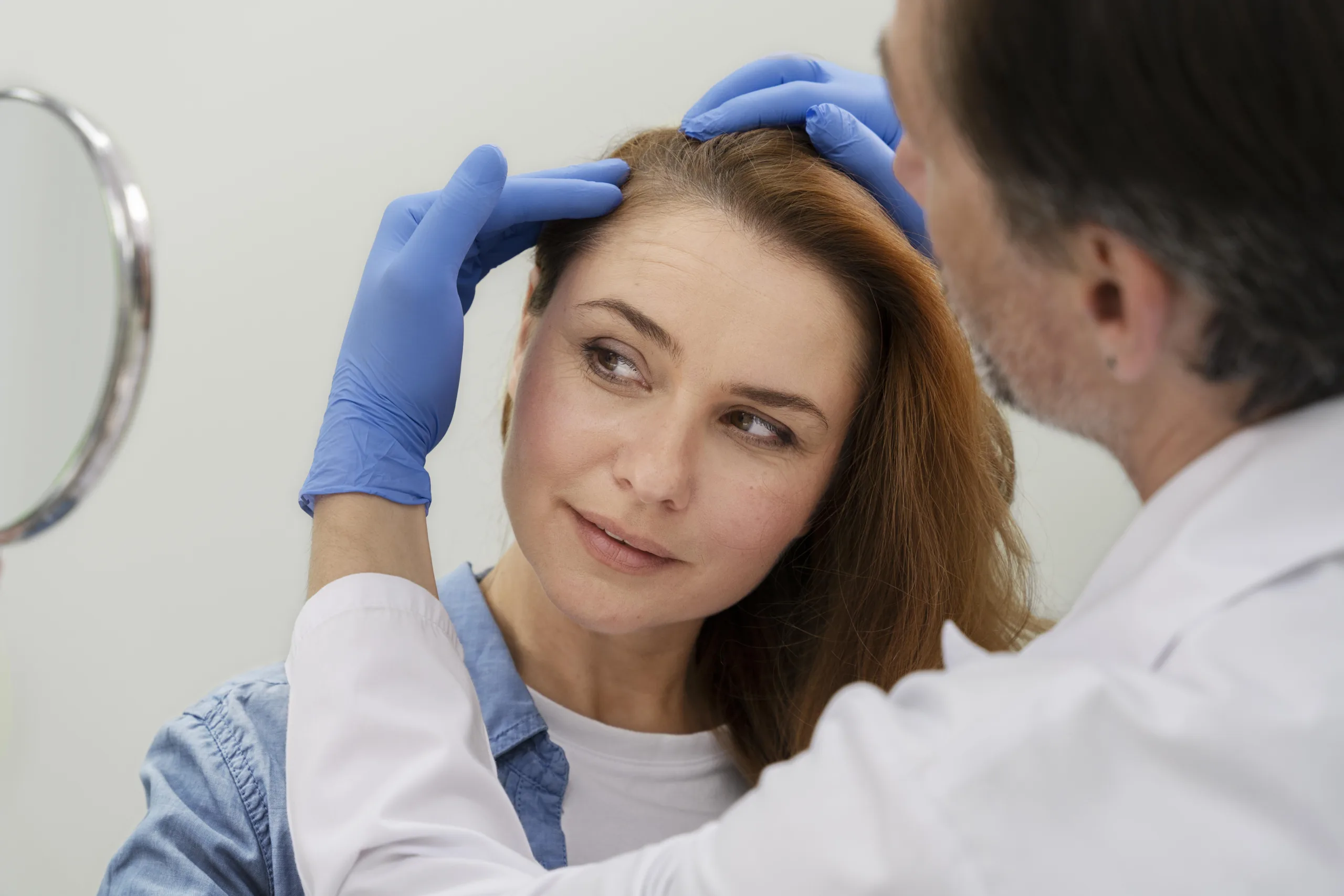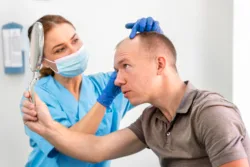Hair loss is not just a male issue, millions of people worldwide suffer from balding and thinning hair. For many women, having hair is an essential component of their identity, confidence, and masculinity; it is not simply about beauty. Anxiety, social discomfort, and mental suffering can all result from hair loss. Women have been using hair transplant procedures more and more in recent years since they provide long-term solutions and outcomes that seem natural. However, treating hair loss in women presents specific challenges that need specialist methods. In this blog we will discuss the causes of hair loss, the challenges performing hair transplants in women, modern treatments, and professional advice for the best outcomes.
Understanding Hair Loss in Women
Female hair loss can frequently come on by a combination of lifestyle, hormonal, and genetic factors. In contrast to men, who usually have bald spots or thinner hairlines, women frequently notice diffuse thinning throughout the scalp. The most common types of hair loss in women are:
1. Androgenetic Alopecia
Female pattern hair loss (FPHL) is the most common cause of hair thinning in women. It is characterized by a widening part and thinning at the crown. This condition, also known as female pattern hair loss, is influenced by both genetics and male hormones called androgens. As a result, women experiencing FPHL may notice gradual changes in hair density over time. In many cases, these changes can significantly impact confidence and self-image.
2. Telogen Effluvium
Stress, disease, hormonal changes, or nutritional deficiencies are common causes of hair loss, which is often temporary but can last for many months.
3. Alopecia Areata
Patchy hair loss is a symptom of the autoimmune disorder alopecia areata. Alopecia totalis, or entire scalp hair loss, or alopecia universalis, or total body hair loss, are possible outcomes.
4. Traction Alopecia
Tight hairstyles such as ponytails, buns, and braids can lead to a condition called traction alopecia, which results in hair loss. Over time, the continuous pulling places excessive stress on the hair, potentially causing permanent damage to the follicles. Consequently, individuals who frequently wear these styles may notice gradual thinning or bald patches. To prevent this, it’s important to alternate hairstyles and reduce tension on the scalp.
5. Scarring Alopecias
Scarring alopecia are uncommon disorders in which hair follicles are permanently destroyed by inflammation. In order to avoid permanent hair loss, early diagnosis and treatment are essential.
Key Challenges of Hair Transplant in Women
Even though hair transplant techniques have advanced, treating female hair loss has different difficulties than treating male hair loss:
1. Diffuse Hair Thinning
Problem: In women, bald spots are more uncommon than thinning over the entire scalp. Because of this, maintaining natural density while collecting enough donor hair is challenging.
Solution: PRP (Platelet-Rich Plasma) therapy or low-level laser therapy may be used in conjunction with hair transplantation by surgeons to boost existing hair and increase overall density.
2. Limited Donor Hair Supply
Problem: Many women have smaller patches of permanent hair on the sides and back of their scalps, which limits the number of donor follicles that are possible.
Solution: With minimum scarring, accurate follicle extraction is made possible by advanced procedures such as FUE. Body hair from the legs or chest may be utilized in specific situations.
3. Hormones Factors
Problem: Hormonal imbalances caused by menopause, thyroid conditions, PCOS, or pregnancy are frequently associated with female hair loss. In fact, these underlying issues are among the most common contributors. Moreover, even after a hair transplant, hormonal changes may still have an impact on hair growth and retention. Therefore, addressing the root hormonal causes is essential for long-term success.
Solution: It is advised to get a comprehensive hormonal examination before surgery. Topical minoxidil, anti-androgen drugs, or lifestyle changes can be used as treatments to stop persistent hair loss.
4. Styling Factors
Problem: Because longer hairstyles are more common among women, little variations in hair density may be noticeable.
Solution: Graft location is carefully considered by surgeons to guarantee natural hair flow, especially around the crown, division, and hairline.
Solutions For Women Hair Restoration
1. Follicular Unit Extraction (FUE)
FUE is perfect for precision placement and limited donor sites since it removes individual follicles with less scarring and quick recovery.
2. Follicular Unit Transplantation (FUT)
FUT produces more follicles every session by removing a scalp strip for grafts. Usually covered behind long hair, it produces a linear scar.
3. Platelet Rich Plasma (PRP)
PRP injections increase graft survival, increase hair quality, and activate dormant follicles. They can be taken in conjunction with a hair transplant for improved outcomes, or they can be used alone for minor thinning.
4. Scalp Micropigmentation (SMP)
Small pigments are used in scalp micropigmentation to provide the appearance of thicker hair, which is perfect for ladies with diffuse thinning hair for whom transplants might not be sufficient.
Tips to Maintain Volume and Texture
For long-lasting results, these recommendations are especially crucial for women who have had hair transplants or who suffer with thinning hair:
• Use Gentle, Sulphate Free Products
Because they remove natural oils, harsh washes can harm delicate hair. As a result, the hair becomes more prone to breakage and dryness. To counter this, use pH-balanced shampoos without sulfates and wash your hair only two to three times a week. This way, you can maintain moisture and protect overall hair health.
• Prevent Heat Damage
Using heat tools often can weaken hair and cause it to lose volume. When at all feasible, let your hair air dry and always apply heat protection.
• Massage the Scalp Regularly
Every day, take five to ten minutes to gently massage the scalp with your hands. You may also use nourishing oils like coconut or argan oil to help promote the health of your follicles and increase blood flow.
• Eat Balanced Diet For Hair Health
Protein, iron, zinc, and vitamins A, C, D, E, and biotin are all necessary for hair development. Consuming fruits, vegetables, nuts, seeds, and lean proteins promotes good hair.
• Protect From Environmental Damage
Pool chlorine, pollution, and UV radiation may all harm hair texture. Wearing a scarf or cap outside and carefully washing your hair after swimming will help protect it.
• Follow Surgeon Instructions
Avoid heavy straining, itching, or chemical treatments for at least 6 to 8 weeks after surgery if you get a transplant. To keep the graft healthy and encourage the growth of new hair, keep taking any prescription drugs or topical therapies as directed by your doctor.
Conclusion:
Women’s hair transplants are a very successful way to boost confidence and hair density. However, there is no one-size-fits-all method for restoring hair in women. It takes an individual approach for dealing with the special problems of general thinning, hormonal effects, and limited donor hair. Advanced methods that produce natural and long-lasting results include FUE, PRP treatment, and appropriate pre- and post-operative care. If you are considering Hair Transplants, then please visit Aestheticure. Our best expertise and experienced surgeons will provide you with the best treatment and proper care and also they will guide you through the procedure, provide you with thoughtful, honest answers to all of your questions. For more information or to schedule a consultation, feel free to Contact Us!







